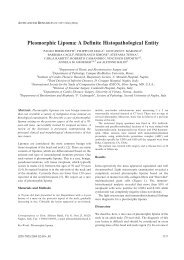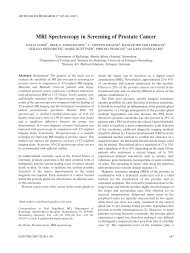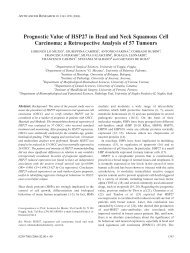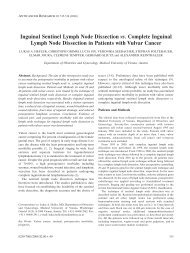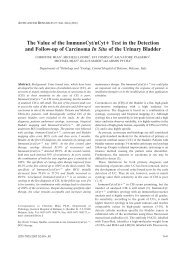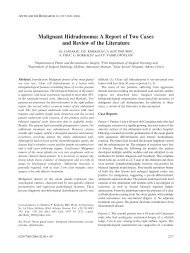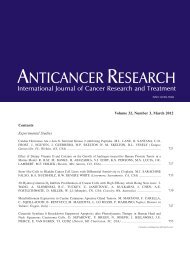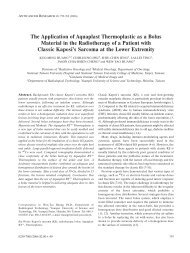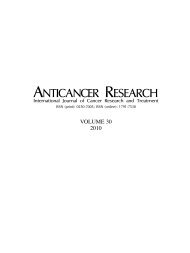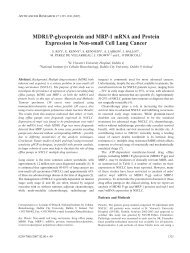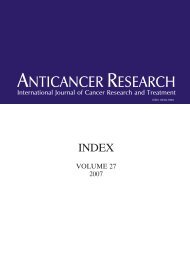ABSTRACTS OF THE 21st ANNUAL MEETING OF THE ITALIAN ...
ABSTRACTS OF THE 21st ANNUAL MEETING OF THE ITALIAN ...
ABSTRACTS OF THE 21st ANNUAL MEETING OF THE ITALIAN ...
Create successful ePaper yourself
Turn your PDF publications into a flip-book with our unique Google optimized e-Paper software.
compared to the traditional Camey II technique. Results: The<br />
results in the short postoperative follow-up did not seem to<br />
differ from those of the original technique in terms of<br />
morphology and urodynamics. However, our technique had a<br />
lower incidence of uretero-ileal anastomotic stenosis,<br />
especially of the left side. Discussion and Conclusion:<br />
Although the Camey II technique is well documented, we<br />
suggest that our modification of this surgical technique<br />
facilitates the descent of the reservoir into the pelvis and<br />
reduces the incidence of uretero-neovesical stenosis.<br />
1 Hautmann RE, de Petriconi RC and Volkmer BG: Lessons<br />
learned from 1,000 neobladders: the 90-day complication<br />
rate. J Urol 184(3): 990-994, 2010.<br />
2 Manoharan M, Ayyathurai R and Soloway MS: Radical<br />
cystectomy for urothelial carcinoma of the bladder: an<br />
analysis of perioperative and survival outcome. BJU Int<br />
104(9): 1227-1232, 2009.<br />
3 Hautmann RE, Abol-Enein H, Hafez K, Haro I, Mansson W,<br />
Mills RD, Montie JD, Sagalowsky AI, Stein JP, Stenzl A,<br />
Studer UE and Volkmer BG: Urinary diversion. World<br />
Health Organization (WHO) Consensus Conference on<br />
Bladder Cancer. Urology 69(1 Suppl): 17-49, 2007.<br />
80<br />
ROLE <strong>OF</strong> SELECTIVE UPPER URINARY TRACT<br />
CYTOLOGY IN PATIENTS WITH SUSPICIOUS<br />
TRANSITIONAL LESIONS<br />
Federico Pellucchi1 , Lorenzo Rocchini1 , Buthaina Ibrahim1 ,<br />
Massimo Freschi2 , Carmen Maccagnano1 , Giuseppe Zanni1 ,<br />
Niccolo’ Passoni1 , Nicola Fossati1 , Luca Villa1 ,<br />
Giorgio Gandaglia1 , Paolo Capogrosso1 and Renzo Colombo1 1Urologia and 2Anatomia Patologica, I.R.C.C.S. San<br />
Raffaele, Universitá Vita-Salute, Milano, Italy<br />
Aim: To evaluate both sensitivity and specificity of urinary<br />
cytology obtained by selective upper-tract (UT) washing in<br />
predicting transitional cell carcinoma (TCC) when compared<br />
to bladder-voided cytology and radiological imaging in a<br />
selected series of patients with suspicious transitional tumor.<br />
Patients and Methods: Between 1991 and 2009, 127<br />
consecutive patients with a clinical suspicion of UT-TCC<br />
underwent selective UT washing, bladder urinary cytology and<br />
radiological imaging. After completion of clinical assessment,<br />
all patients underwent a surgical approach for or biopsy of any<br />
suspicious lesion. Based on histology, both sensitivity and<br />
specificity of selective UT washing cytology were assessed and<br />
also compared with bladder-voided cytology and radiological<br />
imaging results. Results: The mean patient age was 65.9<br />
(range: 34-84) years; 25 patients were female (19.7%). Eighty-<br />
1852<br />
ANTICANCER RESEARCH 31: 1807-1956 (2011)<br />
eight patients (69.3%) had a previous history of bladder TCC.<br />
The suspicion of UT-TCC was based on radiological imaging<br />
in 69 patients (54.3%), positive voided cytology without<br />
evidence of bladder disease in 37 patients (29.2%) and<br />
hematuria in the remaining 21 patients (16.5%). All patients<br />
had at least one negative cystoscopy before surgery. Overall,<br />
50 patients (39.4%) underwent surgery with histological<br />
diagnosis of UT-TCC (26 patients with transitional kidney<br />
cancer, 21 patients with ureteral transitional cancer and 3<br />
patients with concomitant kidney and ureteral tumor), with<br />
high prevalence of high-grade cancer. The number of cases of<br />
pTa, pT1, pT2, pT3 and pT4 at surgery were: 13 (7.4%), 12<br />
(6.9%), 6 (3.4%), 14 (8%) and 1 (0.6%), respectively. The<br />
remaining patients were only followed up. The mean followup<br />
was 36.5 (median: 12; range: 1-180) months. The sensitivity<br />
of voided urinary cytology was 48.65% and specificity was<br />
69.35%, with positive and negative predictive values (PPV and<br />
NPV, respectively) of 48.65% and 69.35%, respectively.<br />
Sensitivity and specificity of selective UT washing were<br />
76.60% and 91.25%, respectively, with PPV of 83.72% and<br />
NPV of 86.90%. In this series of patients, radiological imaging<br />
had a low accuracy (sensitivity, specificity, PPV and NPV were<br />
85.29%, 29.82%, 42.03% and 77.27%, respectively).<br />
Discussion and Conclusion: Radiological imaging had high<br />
sensitivity for primary screening in patients with suspected UT-<br />
TCC. Selective UT washing cytology had higher specificity<br />
than either bladder cytology or radiology. These findings<br />
support the use of selective UT washing as a reliable secondlevel<br />
tool for patients with positive voiding cytology and<br />
negative or suspicious UT imaging.<br />
81<br />
PROSTATIC CAPSULE-SPARING CYSTECTOMY<br />
FOR ORGAN-CONFINED BLADDER CANCER:<br />
A SINGLE-INSTITUTION EXPERIENCE<br />
WITH LONG-TERM FOLLOW-UP<br />
Renzo Colombo, Nazareno Suardi, Lorenzo Rocchini,<br />
Federico Pellucchi, Carmen Maccagnano, Buthaina Ibrahim,<br />
Luca Villa, Giuseppe Zanni, Niccoló Passoni,<br />
Giorgio Gandaglia, Paolo Capogrosso and Patrizio Rigatti<br />
I.R.C.S.S. San Raffaele, Universitá Vita-Salute, Milano, Italy<br />
Background: Prostatic capsule and seminal-sparing cystectomy<br />
(CSSC) has been proposed for young (age



